
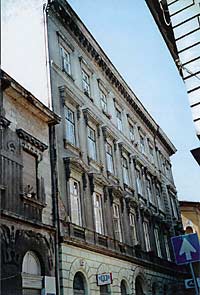 Erzsi's
flat couldn't have been better. We could walk to it in 10 minutes from Deak
Ter, the Metro terminal in downtown Pest. Having wondered politely why I was
turning circles down the pavement, Erzsi caught my spirit of landmark checking
in both directions. The wide boulevard, or Korut, with tram lines in the centre
could be one of many, and just where and in which direction were the turn-offs?
She pointed out for the corner restaurant with beer signs hanging out that to
her meant 'nearly home now'. "Oh, it looks really nice and friendly, but
I'll never remember it. How about the building with the pale blue Daewoo sign
right up its front, nearly hitting the sky?" Two storeys above the pavement,
the sign covered the front of the building, pushing the blackened gothic window
ledges, and modest spires and tracery of the neighbouring buildings into retreat.
"You're right," she said. "If you want to find your own way tomorrow.
You know, I hardly ever notice it." And we laughed at how it is, living
in a place, or just landing in one.
Erzsi's
flat couldn't have been better. We could walk to it in 10 minutes from Deak
Ter, the Metro terminal in downtown Pest. Having wondered politely why I was
turning circles down the pavement, Erzsi caught my spirit of landmark checking
in both directions. The wide boulevard, or Korut, with tram lines in the centre
could be one of many, and just where and in which direction were the turn-offs?
She pointed out for the corner restaurant with beer signs hanging out that to
her meant 'nearly home now'. "Oh, it looks really nice and friendly, but
I'll never remember it. How about the building with the pale blue Daewoo sign
right up its front, nearly hitting the sky?" Two storeys above the pavement,
the sign covered the front of the building, pushing the blackened gothic window
ledges, and modest spires and tracery of the neighbouring buildings into retreat.
"You're right," she said. "If you want to find your own way tomorrow.
You know, I hardly ever notice it." And we laughed at how it is, living
in a place, or just landing in one.
 As
we turned into Dob utca it seemed unremarkable, a narrow turning between high
buildings with some litter scattered along. But the street had its own surprises.
The traffic had decreased to the odd car, and I was watching out for the couple
of men who were walking past rather stiffly, a bottle in hand. The pavement
widened in front of a whitewashed house wall. Low walls retained beds with a
few shrubs, and a couple of men were sitting there too - but with a very sober
sort of drunkenness - just passing the time in the late afternoon sun. And then
there was an amazing statue. At first it just catches your eye as a swoop of
metal, and then you see the figure on the ground with the hand reaching up,
and the one at the top, with wings - letting go or reaching out? The lovely
ambiguity of this I found in my Guide, when I realised I was indeed in one of
the best described parts of Pest, Section VII, specially recommended to travellers
who want to stay in private homes rather than in hotels. The statue's officially
a monument to the Swiss consul Carl Lutz, who gave help to the Jews in the Ghetto,
but then gave in to Gestapo threats. Unofficially its title is "the figure
jumping out of the window" (otherwise known in Prague as 'defenestration').
As
we turned into Dob utca it seemed unremarkable, a narrow turning between high
buildings with some litter scattered along. But the street had its own surprises.
The traffic had decreased to the odd car, and I was watching out for the couple
of men who were walking past rather stiffly, a bottle in hand. The pavement
widened in front of a whitewashed house wall. Low walls retained beds with a
few shrubs, and a couple of men were sitting there too - but with a very sober
sort of drunkenness - just passing the time in the late afternoon sun. And then
there was an amazing statue. At first it just catches your eye as a swoop of
metal, and then you see the figure on the ground with the hand reaching up,
and the one at the top, with wings - letting go or reaching out? The lovely
ambiguity of this I found in my Guide, when I realised I was indeed in one of
the best described parts of Pest, Section VII, specially recommended to travellers
who want to stay in private homes rather than in hotels. The statue's officially
a monument to the Swiss consul Carl Lutz, who gave help to the Jews in the Ghetto,
but then gave in to Gestapo threats. Unofficially its title is "the figure
jumping out of the window" (otherwise known in Prague as 'defenestration').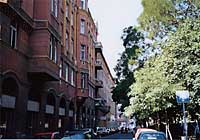 Erzsi was still doubtful whether her flat was the right place to invite anyone
to. "I don't think it's bad," she explained, "but all my friends
ask how I can possibly live in this area." Yet her pleasure in the street
was easy to follow, as she pointed up to the house facades that struggled to
show their 19th century grandeur, the storeys of elegant windows rising up to
the smaller attic, the crumbling parapet and roof guttering giving away the
internal problems. Some residents tried to bring a little green to the broken
stone of their window ledge, with a cluster of small pots. There were ordinary
people walking home with a briefcase, or a plastic two-handled shopping bag.
They went in and out of the little supermarket or discount store with the metal
grille over the door, coloured by beer and cigarette signs.
Erzsi was still doubtful whether her flat was the right place to invite anyone
to. "I don't think it's bad," she explained, "but all my friends
ask how I can possibly live in this area." Yet her pleasure in the street
was easy to follow, as she pointed up to the house facades that struggled to
show their 19th century grandeur, the storeys of elegant windows rising up to
the smaller attic, the crumbling parapet and roof guttering giving away the
internal problems. Some residents tried to bring a little green to the broken
stone of their window ledge, with a cluster of small pots. There were ordinary
people walking home with a briefcase, or a plastic two-handled shopping bag.
They went in and out of the little supermarket or discount store with the metal
grille over the door, coloured by beer and cigarette signs.
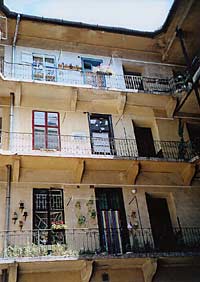 Further
down, the street suddenly opened out on the right into a green square, with
children's voices above the creak of swings, and a large dog snuffling at the
railings from the inside - a well divided off dog exercise area. Erzsi was still
sounding apologetic, and I was a little disappointed, as she keyed in a number
and pushed against a heavy modern metal and glass door. Inside all changed.
We were in a dark passageway with vaulted openings, and stacks of wood pushed
into the corners. Battered metal post boxes, and a bicycle propped up - it was
makeshift modern life in a passage that travelled back decades. Just as in the
'highly recommended' old part of Lyon, the blackened passage opened on the left
into a small square courtyard, surrounded by black-railed balconies on every
floor. The inner walls rose up a dull ochre yellow, three or four storeys, to
the small square of blue sky above. I couldn't believe my luck. "This is
wonderful. Beautiful. I love old buildings like this. I didn't hope I could
stay in one."
Further
down, the street suddenly opened out on the right into a green square, with
children's voices above the creak of swings, and a large dog snuffling at the
railings from the inside - a well divided off dog exercise area. Erzsi was still
sounding apologetic, and I was a little disappointed, as she keyed in a number
and pushed against a heavy modern metal and glass door. Inside all changed.
We were in a dark passageway with vaulted openings, and stacks of wood pushed
into the corners. Battered metal post boxes, and a bicycle propped up - it was
makeshift modern life in a passage that travelled back decades. Just as in the
'highly recommended' old part of Lyon, the blackened passage opened on the left
into a small square courtyard, surrounded by black-railed balconies on every
floor. The inner walls rose up a dull ochre yellow, three or four storeys, to
the small square of blue sky above. I couldn't believe my luck. "This is
wonderful. Beautiful. I love old buildings like this. I didn't hope I could
stay in one."
"But the flat is very small. We've only had it for a few weeks. It's for
my sister and me. It's not finished yet. I don't know if you'll like it."
Erzsi went to a grille door in the far left corner. The cemented flooring was
clean with assorted troughs and white plastic urns. The fuchsias and geraniums
were struggling to bloom in the few hours of sunlight that reached right down.
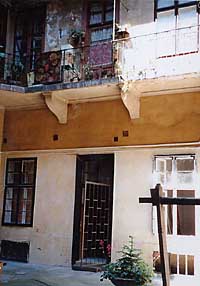 "It's
not finished," she said again. "My cousin has been helping."
And indeed the front door opened onto a pile of paint buckets, long poles, and
the kitchen. It was much like the kitchens we had in various bed-sits as students
- minimal, with a scary gas stove. But as I looked through into the main room,
my gaze travelled up, and up, and the line of the wall curved up and up, and
I was just amazed at the thought that they had painted it such a clean white
by themselves. It was far too high for any ordinary ladder. It could have been
the wine cellar of an ancient castle. There was a stove too, an extraordinarily
square ceramic tiled stove, caramel brown with discrete engravings. I tried
hard to like it. If it had been squat it might have been OK, or with a bench
round, or something homely, but it stood taller than me - functional - and ugly
grey gas pipes fed into it from an angle along the wall. It wasn't quite clear
why they couldn't have been fitted straight. Was it fair to think that they,
along with the huge boiler in the bathroom, large enough for a whole family,
said most clearly, 'socialism has been here'? But the girls were making it heir
own and a woven cloth hammock, a good 2 metres in length, stretched its warm
browns and reds across the corner of the room. A wall cupboard was clearly what
Erzsi said, a useful left over from the previous occupants, and a made up sofa
bed and settee from her parents filled some of the space on the parquet flooring.
Even that looked strange to me, in long narrow herring-bone strips of golden
wood. Erzsi sighed, "I'll have to do it again. Look how rough it is, and
I took such care sanding it.
"It's
not finished," she said again. "My cousin has been helping."
And indeed the front door opened onto a pile of paint buckets, long poles, and
the kitchen. It was much like the kitchens we had in various bed-sits as students
- minimal, with a scary gas stove. But as I looked through into the main room,
my gaze travelled up, and up, and the line of the wall curved up and up, and
I was just amazed at the thought that they had painted it such a clean white
by themselves. It was far too high for any ordinary ladder. It could have been
the wine cellar of an ancient castle. There was a stove too, an extraordinarily
square ceramic tiled stove, caramel brown with discrete engravings. I tried
hard to like it. If it had been squat it might have been OK, or with a bench
round, or something homely, but it stood taller than me - functional - and ugly
grey gas pipes fed into it from an angle along the wall. It wasn't quite clear
why they couldn't have been fitted straight. Was it fair to think that they,
along with the huge boiler in the bathroom, large enough for a whole family,
said most clearly, 'socialism has been here'? But the girls were making it heir
own and a woven cloth hammock, a good 2 metres in length, stretched its warm
browns and reds across the corner of the room. A wall cupboard was clearly what
Erzsi said, a useful left over from the previous occupants, and a made up sofa
bed and settee from her parents filled some of the space on the parquet flooring.
Even that looked strange to me, in long narrow herring-bone strips of golden
wood. Erzsi sighed, "I'll have to do it again. Look how rough it is, and
I took such care sanding it. 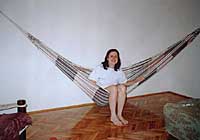 Then
when it was drying the second time around I left the window open and the dust
blew in." I felt the surface of the varnish carefully. It was just slightly
roughened. Such are the joys of new ownership: perpetual awareness of every
blemish that no-one else can see. It seemed to be easy to start chatting. Erzsi
is like that, very warm, enthusiastic, but also a little bit shy and reserved.
Perhaps that's what makes her stutter a little in English. It suits her, the
stutter, it goes along with her being serious and thoughtful. She has very dark
hair that she parts simply in the middle, and is neither short not long, straight
nor wavy. Her brown eyes look straight at you, and she looks quite serious for
a few moments and then she smiles again. And she beams with pleasure at so many
things. Why she hasn't got a hundred boyfriends I don't know. Perhaps she's
too straightforward.
Then
when it was drying the second time around I left the window open and the dust
blew in." I felt the surface of the varnish carefully. It was just slightly
roughened. Such are the joys of new ownership: perpetual awareness of every
blemish that no-one else can see. It seemed to be easy to start chatting. Erzsi
is like that, very warm, enthusiastic, but also a little bit shy and reserved.
Perhaps that's what makes her stutter a little in English. It suits her, the
stutter, it goes along with her being serious and thoughtful. She has very dark
hair that she parts simply in the middle, and is neither short not long, straight
nor wavy. Her brown eyes look straight at you, and she looks quite serious for
a few moments and then she smiles again. And she beams with pleasure at so many
things. Why she hasn't got a hundred boyfriends I don't know. Perhaps she's
too straightforward.

 Erzsi's
flat couldn't have been better. We could walk to it in 10 minutes from Deak
Ter, the Metro terminal in downtown Pest. Having wondered politely why I was
turning circles down the pavement, Erzsi caught my spirit of landmark checking
in both directions. The wide boulevard, or Korut, with tram lines in the centre
could be one of many, and just where and in which direction were the turn-offs?
She pointed out for the corner restaurant with beer signs hanging out that to
her meant 'nearly home now'. "Oh, it looks really nice and friendly, but
I'll never remember it. How about the building with the pale blue Daewoo sign
right up its front, nearly hitting the sky?" Two storeys above the pavement,
the sign covered the front of the building, pushing the blackened gothic window
ledges, and modest spires and tracery of the neighbouring buildings into retreat.
"You're right," she said. "If you want to find your own way tomorrow.
You know, I hardly ever notice it." And we laughed at how it is, living
in a place, or just landing in one.
Erzsi's
flat couldn't have been better. We could walk to it in 10 minutes from Deak
Ter, the Metro terminal in downtown Pest. Having wondered politely why I was
turning circles down the pavement, Erzsi caught my spirit of landmark checking
in both directions. The wide boulevard, or Korut, with tram lines in the centre
could be one of many, and just where and in which direction were the turn-offs?
She pointed out for the corner restaurant with beer signs hanging out that to
her meant 'nearly home now'. "Oh, it looks really nice and friendly, but
I'll never remember it. How about the building with the pale blue Daewoo sign
right up its front, nearly hitting the sky?" Two storeys above the pavement,
the sign covered the front of the building, pushing the blackened gothic window
ledges, and modest spires and tracery of the neighbouring buildings into retreat.
"You're right," she said. "If you want to find your own way tomorrow.
You know, I hardly ever notice it." And we laughed at how it is, living
in a place, or just landing in one.



